EuropeanaTech 2015 projects - where are they now? Ajapaik
With EuropeanaTech 2018 just around the corner, we hear how a couple of projects presented at the 2015 conference have developed. Today, Vahur Puik, from the Estonian Photographic Heritage Society, talks about Ajapaik, a crowdsourcing platform for geotagging historic images.

- Title:
- Screenshots of the Ajapaik app showing rephotography
- Creator:
- Vahur Puik, Ajapaik
- Date:
- 2018
- Institution:
- Estonian Photographic Heritage Society
- Country:
- Estonia
- Copyright:
- CC BY-NC-SA
The project
Ajapaik ('time period' in Estonian), shows how places have changed over time. On the Ajapaik site, you can look for historic images of places from the collections of Estonian museums, mark the pictures of places you know on a map and add your own pictures ('rephotographs') of the same locations to lay over them.
The story back in 2015
At that time, our crowdsourcing platform for geotagging historic images was already four years old but still in kind of a prototype phase as we only had around 4,000 historic photographs on the site, 3,000 of which had been geotagged with the help of users. We also had 700+ 'rephotographs' made largely by a single fanatic rephotographer.
We were convinced that crowdsourced geotagging was possible and that by enriching digitised pictorial heritage with geographic metadata, we could use a map-based interface to access content instead of using the dominant textual searches. But 3,000 images is a tiny fraction when big individual collections have hundreds of thousands or even millions of images.
What's happened since?
Three years later, we have more than 126,000 images (mostly Estonian content from public collections) on the platform and 72,000 pictures have been geotagged. The progress has been considerable and we’ve learned a lot along the way. Unfortunately, we’ve only been able to implement a very little of our long list of ideas of features and improvements.

Number of historic and geotagged photos on Ajapaik. CC BY-NC-SA.
Gamification versus social interaction
One of the central realisations has been the fact that the platform has been designed with mostly pictures in mind – we have been building the app ‘for’ the pictures but the success of a crowdsourcing project depends entirely on the user community. Therefore, we need to focus much more on the users. Since the beginning we’ve used very basic gamification – users get points for their contributions and different tasks give different amounts of points. For instance, a first rephoto added to a historic picture gets 1,250 points, while curating a new historic image only gives 50 and geotagging an image gives between 160 to 300 points. There are different leaderboards for every album which are usually place-specific.
We know from user feedback that gaining points is not motivating enough. More valuable is the social interaction that comes from things like Facebook groups for sharing and discussing historic content.
Although we offer users the option to comment on the images (and we’ve made incremental improvements to the system), it hasn’t taken off. Only a few top contributors use it for sharing additional information about what’s depicted in the image, but there’s no casual debate or emotional posts about the images that are thriving on social media. So we think the focus needs to be more on social interaction and community as opposed to gamification. We need notification systems when users have submitted conflicting suggestions for locations – whether the first user wants to defend his (the user base is predominantly male) opinion or admits his error. Users could ‘sign up’ for a specific place – when new images get added to their home street, they get notified etc.
These kind of features are easy and very natural to imagine (as these are present on the dominating social networks) but are much harder to implement given that just the task of geotagging has plenty of aspects that are not yet there. Aerial photographs, for instance, need a different geotagging interface than normal pictures from the ground.
App screenshot (left) of a rephoto captured before uploading, screenshot (right) of closest images with rephoto indication (blue icon – user has rephotographed the old image, white icon – rephoto made by some other user). Ajapaik, CC BY-NC-SA.
Camera location and rephotography
Since the beginning, we chose the camera location as the geodata that we focus on. There are several reasons for that. First – the camera location is definitive, there was only one place in which the photographer was standing and one direction the camera was facing. In some cases it may be hard or even impossible to determine, but there cannot be two or more different right answers. Camera location is also crucial for the next main task we want users to engage in – rephotography. Taking repeat photos of historic scenes has become more and more popular as the amount of digitised historical content available online is growing. Having pictures geotagged and using a smart device app would make the process even more accessible.
This year at EuropeanaTech 2018
We published the new version of the Android rephotography app in March 2018 on Google Play Store. More about our plans related to crowdsourcing geodata and rephotos of historic images are in my talk at EuropeanaTech 2018. Hope to see you there!


